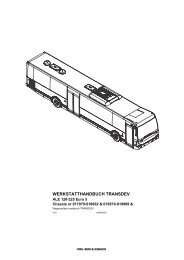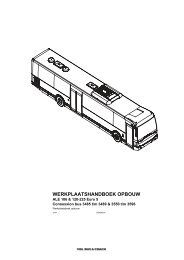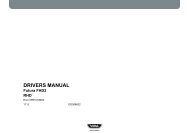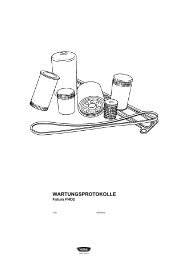DRIVER'S MANUAL SB220GS - Training Registration System
DRIVER'S MANUAL SB220GS - Training Registration System
DRIVER'S MANUAL SB220GS - Training Registration System
Create successful ePaper yourself
Turn your PDF publications into a flip-book with our unique Google optimized e-Paper software.
OIL PRESSURE WARNING LAMP (B5)<br />
The warning lamp lights up when the<br />
ignition is switched on and the engine does<br />
not turn. The lamp go out when the engine<br />
starts.<br />
If the warning lamp does not go out after<br />
starting the engine, or comes on whilst<br />
driving (a buzzer will also sound), stop and<br />
turn the engine off. Check the oil level and<br />
top up if necessary.<br />
If the lamp remains lit even though the oil<br />
level is correct, do not drive any further. The<br />
engine must also not be allowed to idle.<br />
E-GAS WARNING LAMP (C1)*<br />
In the case of a fault with the electronic fuel<br />
system, the warning lamp (C1) flashes or<br />
is lit continuously, depending on the fault. If<br />
the lamp remains continuously lit then the<br />
fault is less serious.<br />
The fault is serious if the lamp flashes and<br />
a service outlet should be warned<br />
immediately.<br />
WARNING LAMP COOLANT<br />
TEMPERATURE/COOLANT LEVEL (C3)<br />
The warning lamp is lit for a couple of<br />
seconds when the ignition is switched on,<br />
just as a routine check on the operation.<br />
If the warning lamp is not extinguished<br />
afterwards, or comes on whilst driving (a<br />
buzzer will also sound), the temperature of<br />
the liquid coolant could be too high or the<br />
liquid coolant level could be too low.<br />
Stop, turn the engine off and check the<br />
liquid coolant level/fan operation. If<br />
necessary, top up the liquid coolant.<br />
If the warning lamp is not extinguished even<br />
when the liquid coolant level and fan<br />
operation are correct, do not drive any<br />
further.<br />
HIGH GENERATOR VOLTAGE WARNING<br />
LAMP (C4)*<br />
The charging voltage is limited by an overvoltage<br />
security device in the dynamo. If,<br />
due to a fault, a voltage greater than 30 V<br />
exists, this warning lamp lights up.<br />
Turn on as many electronic devices as<br />
possible and drive to the nearest repair<br />
workshop. If the lamp still does not go out,<br />
the vehicle must not be driven any further.<br />
CHASSIS HEIGHT ADJUSTMENT<br />
WARNING LAMP (C6)*<br />
The warning lamp is lit for a couple of<br />
seconds when the ignition is switched on,<br />
just as a routine check on the operation.<br />
If the warning lamp lights up whilst driving,<br />
this implies that there is a slight fault. A<br />
number of devices will be switched off. Get<br />
in contact with a DAF BUS workshop as<br />
quickly as possible.<br />
If the warning lamp starts flashing whilst<br />
driving, this implies that there is a serious<br />
fault in the electronic part of the system.<br />
The electronic system switches itself off<br />
completely. The suspension and damping<br />
will no longer be regulated and controlled.<br />
In emergencies, the chassis height can be<br />
adjusted manually using the control<br />
switches. Drive carefully to the nearest DAF<br />
BUS repair workshop at a speed no greater<br />
than 15 km/h.<br />
When a kerb sensor has been fitted by the<br />
constructor, the CHASSIS HEIGHT<br />
ADJUSTMENT warning lamp (C6) and the<br />
VEHICLE NOT ON DRIVING LEVEL/AIR<br />
PRESSURE TOO LOW warning lamp (16)<br />
will flash alternately for 2 seconds, indicating<br />
that the kerb sensor has been activated.<br />
INSTRUMENTS AND CONTROLS<br />
33

















